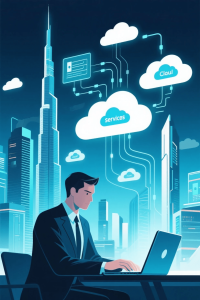Let’s be honest – “cloud computing” can sound like a complicated tech buzzword, right? It feels distant and intimidating.
You’ve probably heard about it, maybe even seen the ads promising amazing efficiency and cost savings. But what is it, and why should you care?
The truth is, cloud computing is transforming how businesses – and increasingly, everyone – operates.
Imagine accessing your data and applications from anywhere, without worrying about storage or expensive servers. It’s about streamlining operations, boosting productivity, and unlocking new possibilities.
That’s exactly what we’ll break down today. We’re going to cut through the jargon and give you a clear, simple understanding of cloud computing – with insights from Saadqain UAE, paving the way for smarter digital solutions.
Cloud Computing Basics Explained
It’s easy to feel overwhelmed by all the jargon surrounding cloud computing – servers, storage, virtualization… it can seem utterly confusing.
Let’s be honest, many explanations start with complex technical details that leave most people feeling even more lost.
But understanding the core concepts doesn’t need to feel like climbing a mountain. It’s about grasping how businesses and organizations are already using this technology to operate more efficiently.

Essentially, cloud computing is simply accessing software and data over the internet instead of storing it directly on your computer or servers.
Think of it like streaming a movie – you don’t own the DVD, but you still get to enjoy the content without having to manage all the physical discs.
The key is realizing that “the cloud” isn’t some magical black box; it’s about leveraging shared resources for cost-effective and scalable solutions.
And that’s precisely what we’ll break down, step by step, starting with the very basics.
What is Cloud Computing?
Now, cloud computing is essentially about storing and accessing data and applications over the internet instead of your computer’s hard drive. Think of it like this: you don’t need a physical server in your office to run programs – those programs live somewhere else, accessible through the web.
It’s like renting space for your files and software rather than owning them outright. You can access these resources from almost any device—a laptop, tablet, or smartphone—as long as you have an internet connection.
For example, when you use Google Docs or Dropbox, you’re utilizing cloud computing. Your documents aren’t stored solely on your computer; they reside in Google’s or Dropbox’s servers and are accessible from anywhere with an internet connection. This offers flexibility and convenience for accessing your work.
Cloud Service Models Overview
Just cloud service models represent different ways for you to access and use computing resources. It’s really about understanding how your data and applications are stored and managed.
There are three primary models: IaaS, PaaS, and SaaS – each offering a distinct level of control and responsibility. Let’s break them down simply.
IaaS (Infrastructure as a Service): Think of this like renting the raw materials to build your own house. You get servers, storage, and networking—you manage everything else, including operating systems and applications.* **PaaS (Platform as a Service):** This is more like renting an apartment – you still have some control over what goes inside, but the landlord takes care of the building’s infrastructure. You focus on developing and deploying your apps.
SaaS (Software as a Service): This is like subscribing to a streaming service—you simply use the software without worrying about any underlying infrastructure or management.
SaaS, PaaS, and IaaS –
SaaS, PaaS, and IaaS are terms that often sound complicated, but they’re really just different ways businesses can use cloud computing. Let’s break them down in a way that makes sense.
Think of it like ordering pizza – SaaS is like buying a ready-made pizza from a restaurant; you get the finished product and don’t worry about making it yourself. PaaS, on the other hand, is like getting a pizza kit with all the ingredients and instructions—you assemble it but still control the recipe. And IaaS is like renting an empty kitchen – you provide everything to make your own pizza from scratch.
SaaS stands for Software as a Service. You’re using software hosted by someone else, like Salesforce or Google Workspace. PaaS means Platform as a Service; it gives you the tools and environment to build and run applications without managing the underlying infrastructure. IaaS is Infrastructure as a Service – you get access to computing resources like servers, storage, and networking—you manage everything yourself.
Essentially, SaaS offers complete solutions, PaaS provides building blocks, and IaaS gives you raw resources. Each approach caters to different levels of technical expertise and control that a business might need.
Choosing the right model depends on your needs and how much management you want to handle. If you just need to use software, SaaS is perfect. If you’re building custom applications, PaaS makes sense. And if you require maximum flexibility and control over your infrastructure, IaaS might be the best fit.
Understanding Cloud Providers – UAE
While choosing a cloud provider can feel overwhelming, understanding those operating within the United Arab Emirates is key. You’ll find several prominent players offering services tailored for businesses and organizations across the region.
These providers offer data centers strategically located throughout the UAE – in cities like Dubai and Abu Dhabi – which brings significant advantages. This proximity reduces latency, improves response times for applications, and ensures compliance with local regulations. It’s a critical factor when considering where your data resides and how quickly it can be accessed.
Many of these providers have established partnerships with government entities and major corporations in the UAE, solidifying their position as trusted solutions. They understand the specific needs of businesses operating within the country’s regulatory environment – including data privacy laws and security standards.
You’ll notice that some focus heavily on supporting Arabic language applications and content, reflecting the region’s rich linguistic diversity. Others prioritize compliance with local certifications and accreditations which is important for businesses operating in the UAE.
Selecting a provider based in the UAE often translates to enhanced support, faster service delivery, and greater confidence in meeting local operational requirements. It’s about choosing a partner that truly understands and supports your business’s journey within this dynamic market.
Security Considerations in the Cloud
Have you ever considered how safe your data is when it’s stored ‘out there’ – in the cloud? It’s a really important question, especially as more and more businesses move their operations online. Let’s talk about security considerations within cloud computing.
Firstly, understanding shared responsibility is key. The provider of the cloud services – like Amazon Web Services or Microsoft Azure – handles the *security of the infrastructure* itself. This means they’re responsible for things like keeping their servers secure and ensuring the physical data centres are protected. However, *you* are accountable for securing what you put *within* that environment.
Think about it this way: your cloud provider secures the building, but *you* need to lock up your valuables inside! This includes things like passwords, access controls, and ensuring your applications and data are properly protected. It’s a partnership where both sides have responsibilities.
Data encryption is absolutely vital. When you store information in the cloud, it’s often transmitted across networks – which can be vulnerable to interception. Encryption scrambles your data so that even if someone were to access it, they wouldn’t be able to read it without the decryption key.
You should always use strong encryption methods and manage those keys securely. Regularly reviewing these settings is important too – ensuring protocols are up-to-date and following best practices.
Cost Optimization Strategies for Cloud
If optimizing cloud costs seems daunting, it doesn’t have to be. It’s about understanding where your money is going and making smart choices.
One key strategy is regularly reviewing your resource usage. You can see exactly which services are consuming the most compute power or storage space.
Many cloud providers offer dashboards that show this data in real-time. Utilizing these tools, you’ll quickly identify any underutilized resources – things running constantly that aren’t actually being used.
Another important step is right-sizing your instances. You can adjust the size of your virtual machines to match your workload needs. Don’t overspend on a large instance if a smaller one will do!
Think about it this way: If you’re running a simple website, you don’t need a massive server—a small one can handle the job just fine and save you money.
Essentially, consistent monitoring coupled with strategic resource adjustments is the foundation of cost optimization within cloud environments.
Cloud Computing’s Impact on Businesses
Many businesses are finding that cloud computing is fundamentally changing how they operate. It’s not just about storing files online anymore; it’s a complete shift in thinking about technology and resources.
Consider data storage – previously, companies needed massive server rooms filled with expensive hardware. Now, you can store all of that information securely and reliably in the cloud, paying only for what you use. This dramatically reduces upfront costs and ongoing maintenance expenses.
Think about small businesses needing to manage customer data or large corporations handling complex financial records. Cloud solutions offer scalability – meaning they can easily adjust their storage capacity as needs grow, without huge capital investments. It’s a far more flexible and cost-effective approach than maintaining on-premise servers.
Collaboration is another key area of impact. With cloud-based applications, teams across different locations can seamlessly access and work on the same documents in real-time.
This eliminates version control issues, streamlines workflows, and boosts productivity. It means you’re not tied to a specific location or device – you can work from anywhere with an internet connection. This type of interconnectedness is transforming how businesses communicate and innovate.
Emerging Trends in Cloud Tech
People are increasingly turning to cloud computing for a reason – it’s changing how businesses operate. And when you think about ‘Emerging Trends in Cloud Tech,’ there’s a whole lot happening that you should know about.
Let’s start with serverless computing. This is where applications run without you having to manage servers yourself. It simplifies things dramatically, and it’s becoming incredibly popular for smaller projects and rapid development.
Imagine building a website – instead of setting up your own server, you simply deploy your code to the cloud provider, and they handle everything else. That’s the power of serverless!
Then there’s edge computing. Traditionally, data had to travel all the way back to a central cloud server for processing. Edge computing brings the computation closer to where the data is generated – think smart devices, IoT sensors, and even self-driving cars.
This reduces latency (the delay in getting information) and improves response times, which is crucial for applications like real-time video streaming or autonomous vehicles.
And don’t forget about containerization – technologies like Docker that allow you to package your applications with everything they need to run consistently across different environments. It’s a huge boost in portability and efficiency.
Saadqain’s Insights – Future of Cloud
Often, cloud computing seems like a complicated maze. You might hear terms like “servers,” “storage,” and “bandwidth” and feel completely lost. But it doesn’t have to be!
Saadqain’s insights really focus on how this technology is changing the way businesses operate – and soon, how *you* will interact with them.
Think about streaming movies or music. That content isn’t stored solely on your device; it lives in the cloud, delivered to you whenever you want. This means that companies can provide services without needing massive amounts of physical storage space.
Saadqain emphasizes that this shift is about flexibility and accessibility. You gain access to data and applications from anywhere with an internet connection – a huge advantage for collaboration and productivity.
Essentially, Saadqain’s vision highlights the cloud as more than just storage; it’s a dynamic platform offering unprecedented opportunities for innovation and efficiency.
Cloud Computing and Innovation – Case Study
Yes, cloud computing and innovation is a powerful combination. It’s about taking ideas and turning them into reality—quickly and efficiently.
Consider this: A small business in Dubai – let’s call it ‘Innovate Solutions’ – was struggling to manage its growing data and applications. They were spending too much time on IT maintenance, and their systems weren’t scaling with their needs.
They realized that moving to the cloud could solve these problems. Innovate Solutions migrated all of its customer data, marketing tools, and financial records to a secure cloud platform. This immediately freed up valuable staff time allowing them to focus on growing their business.
The key innovation here wasn’t just *moving* to the cloud; it was how they *used* the cloud’s capabilities. They started leveraging data analytics tools within the cloud, gaining insights into customer behavior and optimizing their marketing campaigns in real-time.
This allowed Innovate Solutions to respond faster to market trends, personalize customer experiences, and ultimately, increase sales – all thanks to the power of cloud computing and its ability to fuel innovation.
Practical Cloud Applications for Beginners
What you need to know is that cloud computing isn’t some complicated tech thing—it’s really just about storing and accessing your stuff online. Think of it like this: instead of keeping all your photos on a computer’s hard drive, you store them in the ‘cloud.’
Let’s look at some practical ways you can use the cloud to make life easier. One simple one is using Google Drive or Dropbox for storing documents and sharing files with others. It makes collaboration so much simpler!

You can create a document, share it instantly with someone working on the same project, and everyone sees the latest version in real-time. No more emailing multiple versions back and forth – it’s incredibly efficient.
Another great use is backing up your phone or tablet. Cloud services like iCloud or Google Photos automatically create copies of everything on your device, protecting you from losing precious memories if something happens to the original.
It’s a simple safeguard that provides peace of mind knowing your photos and videos are safe and secure—and accessible from anywhere with an internet connection!
Essentially, cloud computing is about convenience and accessibility. It’s making everyday tasks easier by letting you access your information and collaborate seamlessly from almost any device.
Unlocking Potential: Cloud Computing Isn’t As Complicated As You Think
Businesses are realizing that the future isn’t built in servers, it’s built in the cloud.
Moving operations to the cloud offers a remarkable shift – one where resources scale effortlessly with demand and costs become far more predictable. Many organizations hesitate because they perceive cloud computing as overly technical or intimidating. However, the core concept is remarkably straightforward: utilizing remote servers hosted by providers like Saadqain UAE to store data, run applications, and deliver services instead of relying solely on local hardware. This approach dramatically reduces capital expenditure and streamlines operations.
The sooner organizations embrace this shift, the greater the potential for innovation and growth. Cloud solutions provide access to cutting-edge technologies – from data analytics to artificial intelligence – without massive upfront investments. Furthermore, enhanced collaboration and accessibility become standard features, boosting productivity across teams.
Don’t let complexity hold your organization back. Explore the possibilities of cloud computing today; it’s time to embrace a more agile, efficient, and ultimately, successful future.

